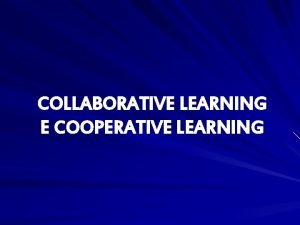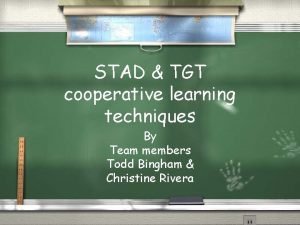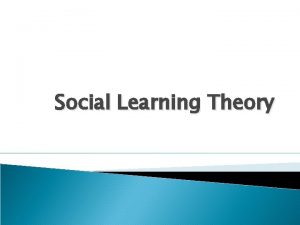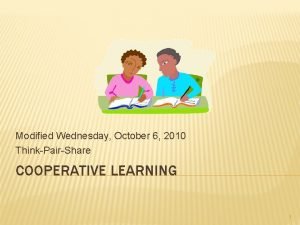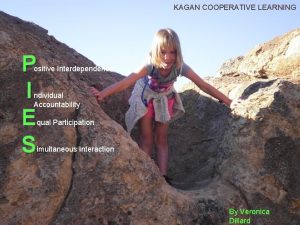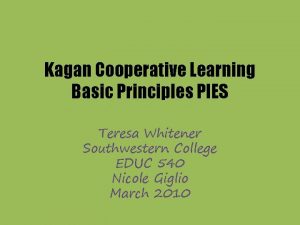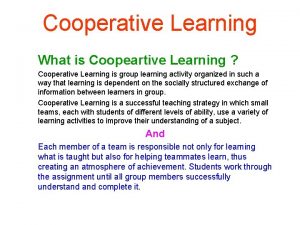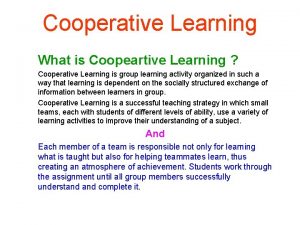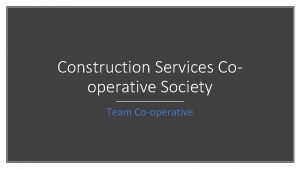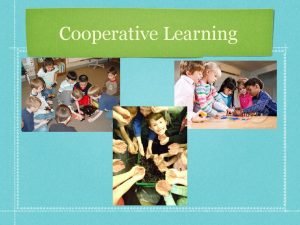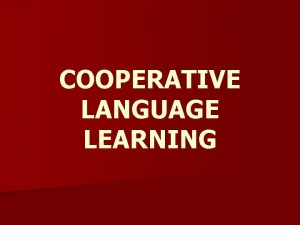Cooperative Learning How Why What is Cooperative Learning










- Slides: 10

Cooperative Learning How & Why

What is Cooperative Learning? According to the United States Department of Education (1992), cooperative learning is a “successful teaching strategy in which small teams, each with students of different levels of ability, use a variety of learning activities to improve their understanding of a subject” (para. 1). “Researchers have shown that group work can induce many beneficial outcomes in comparison to traditional forms of instruction” (Chiu, 2000, p. 27). When students are given the opportunity to work together, they tend to learn more from their peers. Cooperative learning doesn’t have to just take place in a face-to-face setting; it can also take place through technology such as computer games in which students can interact with one another (Smaldino, Lowther, & Russel, 2008).

What Problems Can Cooperative Learning Solve? Ming Chiu (2000) notes that some of the outcomes of cooperative learning include “increased learning, decreased racial tension [and] more positive student attitudes towards school” (p. 28). In a study by Huang et. al. (2012), the authors conclude that “in both self-formed and random groups, students demonstrate high levels of academic achievement and learning satisfaction” and that “interactivity has [a] significant difference” (p. 104). This means that cooperative learning can adequately solve a number of different problems in modern academics. Not only is student success demonstrably higher in cooperative-learning contexts, but interacting with other students in a classroom context has significant social benefits.

What Advantages Does Cooperative Learning Present? Some of the advantages of cooperative learning include the possibility of developing classroom learning groups that stay the same throughout the school year. This provides opportunities for the group members to learn from one another across multiple cooperative learning experiences. Students of different learning abilities and from different backgrounds can work together and learn from one another when using cooperative learning groups. Cooperative learning groups can also include multiple content areas to be addressed during the learning process (Smaldino, Lowther, & Russel, 2008).

What do the Experts Say? “Interaction among students on learning tasks will lead in itself to improved student achievement. Students will learn from one another because in their discussions of the content, cognitive conflicts will arise, inadequate reasoning will be exposed, disequilibration will occur, and higher-quality understandings will emerge” (Pellegrini & Smith, 2000, p. 539). “There is a heightened interest in situations where elaboration, interpretation, explanation, and argumentation are integral to the activity of the group and where learning is supported by individuals” (Woolfolk, 2004, p. 492). “[Cooperative Learning] promotes deep learning of course materials through a diversity of perspectives fostered by interactions between peers…students achieve better grades in CL than in competitive or individual learning” (Shimazoe & Aldrich, 2010, p. 52). The practice of cooperative learning is supported by an extensive body of scholarly work. It presents proven and well-documented advantages over more traditional methods of learning.

How does cooperative learning affect student involvement and learning outcomes? In studies conducted in 2002 and 2004, California State University economics professor Steven Yamarik found that: • “Cooperative learning raised student-instructor interaction. Students seemed less inhibited about asking questions in the small groups” • “Cooperative learning increased group studying for the exams. Students in the cooperative learning sections were more likely to develop study groups” • “The novelty of working in small groups sparked greater interest in the material”(Yamarik, 2007, p. 275). This supported the earlier findings of Howard University professors Constance Ellison and M. Wade Boykin, who concluded that, “cooperative learning methods enhance performance more than do individualistic methods. ” Their research also determined that, “the enhancing effects of cooperative learning situations are not limited to performance outcomes, but extend to attitudinal and on-task activity factors as well” (Ellison and Boykin, 1994, p. 100).

How do We Learn Cooperatively? Whether students form their own groups or are split into groups by a teacher, cooperative learning presents distinct, measurable advantages over more traditional methods of learning. • An overall goal for a group means that individual students are more likely to “pitch in” and help, since they aren’t concentrated solely on individual achievement. • Students are more likely to be responsible, since the academic success of others depends on them. • Students support each other by “helping, sharing, assisting, explaining, and encouraging” (Johnson & Johnson, 2004, p. 25). • Students develop social skills and utilize those social skills in the achievement of specific academic goals. • Finally, groups of students, as opposed to a single student, monitor themselves more effectively in terms of the pursuit of academic success (Johnson & Johnson, 2004, pp. 24 -25).

Conclusion As anthropologist Ashley Montague notes, “Without the cooperation of its members society cannot survive, and the society of man has survived because the cooperativeness of its members made survival possible” (cited in Johnson & Johnson, n. d. , para. 1). Human beings are a powerfully social species, and we live, work, create, and even learn communally. Cooperative learning is simply an extension of this fundamental part of human nature. Because of this, cooperative learning presents many benefits on an educational level. Students who are engaged in cooperative learning tend to do better work as well as develop important social skills during the accomplishment of their group’s goals. Though cooperative learning can be implemented either formulaically or informally, the benefits are the same: increased student success and substantial improvements in the quality of academic work (Johnson & Johnson).

References Chiu, M. M. (2000). Group problem-solving processes: Social interactions and individual actions. Journal for the Theory of Social Behavior, 30(1), 27 -49. Ellison, C. M. , & Boykin, A. (1994). Comparing outcomes from differential cooperative and individualistic learning methods. Social Behavior & Personality: An International Journal, 22(1), 91 -104. Huang, M. , Hsiao, W. , Chang, T. , & Hu, M. (2012). Design and implementation of a cooperative learning system for digital content design curriculum: Investigation on learning effectiveness and social presence. Turkish Online Journal of Educational Technology, 11(4), 94 -107. Retrieved from http: //www. tojet. net/articles/v 11 i 4/1149. pdf Johnson, D. , & Johnson, R. (n. d. ). An overview of cooperative learning. Retrieved from http: //www. cooperation. org/home/introduction-to-cooperative-learning/ Johnson, D. , & Johnson, R. (2004). Assessing students in groups. Thousand Oaks, CA: Corwin Press. Pellegrini, S. & Smith, P. (2000). Psychology of education: Major themes. London, UK: Routledge. Shimazoe, J. , & Aldrich, H. (2010). Group work can be gratifying: Understanding and overcoming resistance to cooperative learning. College Teaching, 58(2), 52 -57. Smaldino, S. E. , Lowther, D. L. , Russell, J. D. (2008). Instructional technology and media for learning (9 th ed. ). Upper Saddle River, NJ: Prentice Hall. U. S. Department of Education, Office of Research (1992). Cooperative Learning. Retrieved from http: //www 2. ed. gov/pubs/OR/Consumer. Guides/cooplear. html Woolfolk, Anita (2004). Educational psychology (9 th ed. ). Boston: Pearson Education. Yamarik, S. (2007). Does cooperative learning improve student learning outcomes? Journal of Economic Education, 259 -277. 38(3),

Notes Photograph of Harvard Yard (slide 5) from Wikimedia Commons. All other photographs courtesy of freestockphotos. biz. All photographs are public domain and copyright-free. This slideshow was created by: Kristen Corcoran Lisa Kisling Marc Molnar Lisa Tanno Jacob Wiker for ETE 501: Technology Strand w/ Dr. Aries Cobb.
 Hey hey bye bye
Hey hey bye bye Collaborative learning vs cooperative learning
Collaborative learning vs cooperative learning Don't ask why why why
Don't ask why why why Cooperative vs collaborative learning
Cooperative vs collaborative learning Tgt cooperative learning
Tgt cooperative learning Cooperative vs collaborative learning
Cooperative vs collaborative learning Pedagogia non direttiva rogers
Pedagogia non direttiva rogers Think pair share cooperative learning
Think pair share cooperative learning Pies kagan cooperative learning
Pies kagan cooperative learning Pies cooperative learning
Pies cooperative learning Ic camigliano
Ic camigliano

